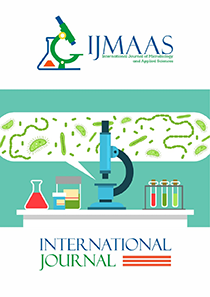Evaluation of Bioremediation Potential of Biosurfactant Producing Bacteria Isolated from Crude Oil Polluted Soil
Vol 3, Issue 1, 2024
KEYWORDS
Biosurfactant (rhamnolipid), hydrocarbon contaminated soil, hydrocarbon utilizing bacteria, bioremediation.
Abstract
Bioremediation technique depends on the ability of microorganisms to break down pollutants that are released into the environment. Evaluation of bioremediation potential of biosurfactant-producing bacteria isolated from hydrocarbon contaminated soil was investigated. Hydrocarbon contaminated soil was collected at different points in OB/OB flow station in Ogba/Egbema/Ndoni L.G.A, River State using hand auger. Each experimental set up of contaminated soil and control set up contained 500g of soil. The set up was augmented with 25ml of the selected biosurfactant producing bacteria (Pseudomonas koreensis (Pseu), Bacillius mycoides (Bac), and biosurfactant (rhamnolipid) except the two (2) controls. Bioremediation process monitoring lasted for 70 days, at 14 days’ interval. Physicochemical properties and bacterial load of treated soil were analyzed using standard methods. Percentage bioremediation was estimated from amount of total petroleum hydrocarbon (TPH) reduction. ANOVA was used to ascertain significant difference of various treatments. The highest amount of hydrocarbon removed and % remediation efficiency after 70 days with treatment was Cs+Bac+Pseu+bios 5287.62mg/kg (78.07%) while controls were Cs (69.1%) and Uc (0%). The highest count for total heterotrophic bacteria for the set ups was recorded on day28 Cs+Bac+Pseu+Bio (9.20×108cfu/g). The highest count of hydrocarbon utilizing bacteria (HUB) was on day42 by CS + Bac + Pseu + Bio (9.40×106cfu/g). Results from the study revealed that the Bacillus mycoides, Pseudomonas koreensis and rhamnolipids and their consortium are capable of remediating TPH in crude oil contaminated soil. There was a faster removal of hydrocarbon by mixed cultures than individual strains. It is recommended that, these known Biosurfactant producing and hydrocarbon degrading isolates like Pseudomonas koreensis, Bacillus mycoides should be harnessed, improved and applied in the bioremediation of petroleum hydrocarbon impacted ecosystem since bioremediation via effective microorganisms and biosurfactants remains an effective, viable as well as a promising strategy for the cleanup of crude oil contaminated environment.
Current: Vol. 3, Issue 2, 2024

Call for papers
The International Journal of Microbiology and Applied Sciences warmly welcome your valuable articles for publication.
